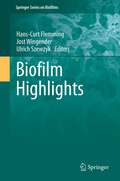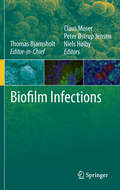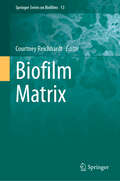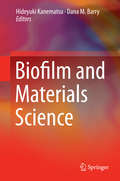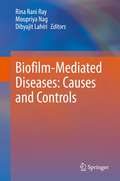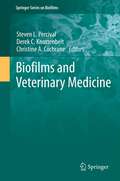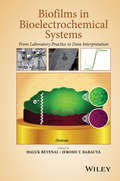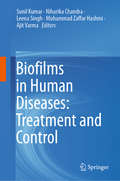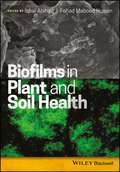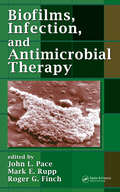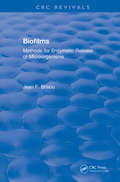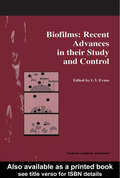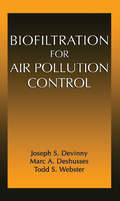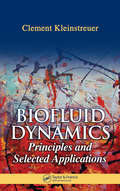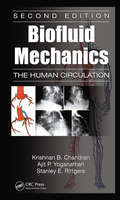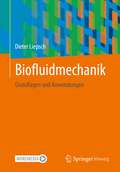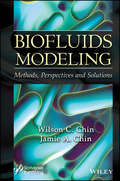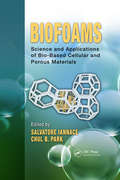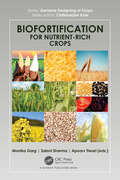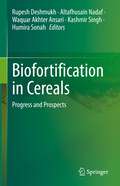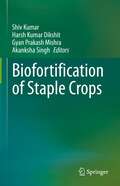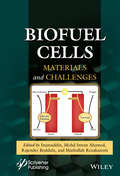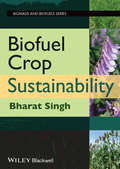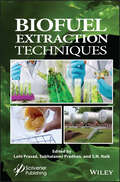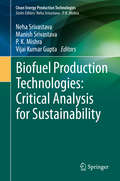- Table View
- List View
Biofilm Highlights (Springer Series on Biofilms #5)
by Hans-Curt Flemming Jost Wingender Ulrich SzewzykLiving in biofilms is the common way of life of microorganisms, transiently immobilized in their matrix of extracellular polymeric substances (EPS), interacting in many ways and using the matrix as an external digestion and protection system. This is how they have organized their life in the environment, in the medical context and in technical systems - and has helped make them the oldest, most successful and ubiquitous form of life. In this book, hot spots in current biofilm research are presented in critical and sometimes provocative chapters. This serves a twofold purpose: to provide an overview and to inspire further discussions. Above all, the book seeks to stimulate lateral thinking.
Biofilm Infections
by Claus Moser Thomas Bjarnsholt Niels Høiby Peter Østrup JensenThis book will cover both the evidence for biofilms in many chronic bacterial infections as well as the problems facing these infections such as diagnostics and treatment regimes. A still increasing interest and emphasis on the sessile bacterial lifestyle biofilms has been seen since it was realized that that less than 0.1% of the total microbial biomass lives in the planktonic mode of growth. The term was coined in 1978 by Costerton et al. who defined the term biofilm for the first time.In 1993 the American Society for Microbiology (ASM) recognised that the biofilmmode of growth was relevant to microbiology. Lately many articles have been published on the clinical implications of bacterial biofilms. Both original articles and reviews concerning the biofilm problem are available.
Biofilm Matrix (Springer Series on Biofilms #13)
by Courtney ReichhardtThis book provides a comprehensive review of biofilm matrices. The main topics include an introduction to biofilm matrices and the range of biofilm matrix components (i.e., biofilm matrixome) as well as an overview of what is known about matrix structure, functionality, and regulation. Additional topics include recent progress in investigating the biofilm matrixome as well as challenges and outstanding questions and descriptions of the influence of matrix interactions on biofilm architecture and pathogen-host interactions. This book covers an important aspect of biofilm biology-microbial biofilm matrices. Microbes form multicellular aggregates called biofilms, in which microbial cells are encased in an extracellular matrix. This enables microbes to withstand harsh environmental conditions including antibiotic treatment. Biofilms are ubiquitous in the environment and can be both beneficial and harmful. For example, they can be used to clean up wastewater, but they also cause serious and chronic infections. It is estimated that over 80% of infections in the United States are biofilm-associated. Some examples of biofilm-involved infections include infections of implanted medical devices or artificial joints and also chronic infections of burns and wounds, including diabetic ulcers. When biofilms show up during infections or human health problems, they act very differently than planktonic bacteria. For example, biofilms can be ~1000-fold more tolerant of antibiotics than their planktonic counterparts. The biofilm matrix is thought to be a key part of why these bacterial infections are so difficult to treat. Biofilm matrix composition varies between bacterial strains and under different growth conditions. In general, the biofilm matrix is rich in biopolymers and can contain exopolysaccharides, proteins, extracellular DNA (or eDNA), and lipids. The biofilm matrix promotes attachment and structurally reinforces bacterial aggregates, preventing clearance by mechanical forces. The matrix can even block antibiotics from accessing the bacteria or prevent the host immune system from seeing the bacteria. The target audience of this book is both established biofilm researchers and those who are newly learning about biofilms and biofilm matrices.
Biofilm and Materials Science
by Hideyuki Kanematsu Dana M. BarryThis book explains the formation of biofilm on materials surfaces in an industrial setting. The authors describe new developments in understanding of biofilm formation, detection, and control from the viewpoint of materials science and engineering. The book details the range of issues caused by biofilm formation and the variety of affected industries.
Biofilm-Mediated Diseases: Causes and Controls
by Rina Rani Ray Moupriya Nag Dibyajit LahiriThis book reviews the current concepts in biofilm formation and its implications in human health and disease. The initial chapters introduce the mechanisms of biofilm formation and its composition. Subsequently, the chapters discuss the role of biofilm in acute and chronic infections. It also explores the pivotal role of both innate and adaptive immunity on the course of biofilm infection. In addition, the book elucidates the bacterial biofilm formation on implantable devices and the current approaches to its treatment and prevention. It analyzes the possible relationship between antimicrobial resistance and biofilm formation. Finally, the book also summarizes the current state-of-the-art therapeutic approaches for preventing and treating biofilms. This book is a useful resource for researchers in the field of microbiology, clinical microbiology, and also medical practitioners.
Biofilms and Veterinary Medicine (Springer Series on Biofilms #6)
by Steven L. Percival Derek C. Knottenbelt Christine A. CochraneBiofilms are implicated in many common medical problems including urinary tract infections, catheter infections, middle-ear infections, dental plaque, gingivitis, and some less common but more lethal processes such as endocarditis and infections in cystic fibrosis. However, the true importance of biofilms in the overall process of disease pathogenesis has only recently been recognized. Bacterial biofilms are one of the fundamental reasons for incipient wound healing failure in that they may impair natural cutaneous wound healing and reduce topical antimicrobial efficiency in infected skin wounds. Their existence explains many of the enigmas of microbial infection and a better grasp of the process may well serve to establish a different approach to infection control and management. Biofilms and their associated complications have been found to be involved in up to 80% of all infections. A large number of studies targeted at the bacterial biofilms have been conducted, and many of them are referred to in this book, which is the first of its kind. These clinical observations emphasize the importance of biofilm formation to both superficial and systemic infections, and the inability of current antimicrobial therapies to 'cure' the resulting diseases even when the in vitro tests suggest that they should be fully effective. In veterinary medicine the concept of biofilms and their role in the pathogenesis of disease has lagged seriously behind that in human medicine. This is all the more extraordinary when one considers that much of the research has been carried out using veterinary species in experimental situations. The clinical features of biofilms in human medicine is certainly mimicked in the veterinary species but there is an inherent and highly regrettable indifference to the failure of antimicrobial therapy in many veterinary disease situations, and this is probably at its most retrograde in veterinary wound management. Biofilms and Veterinary Medicine is specifically focused on discussing the concerns of biofilms to health and disease in animals and provides a definitive text for veterinary practitioners, medical and veterinary students, and researchers.
Biofilms in Bioelectrochemical Systems
by Jerome T. Babauta Haluk BeyenalThis book serves as a manual of research techniques for electrochemically active biofilm research. Using examples from real biofilm research to illustrate the techniques used for electrochemically active biofilms, this book is of most use to researchers and educators studying microbial fuel cell and bioelectrochemical systems. The book emphasizes the theoretical principles of bioelectrochemistry, experimental procedures and tools useful in quantifying electron transfer processes in biofilms, and mathematical modeling of electron transfer in biofilms. It is divided into three sections: Biofilms: Microbiology and microbioelectrochemistry - Focuses on the microbiologic aspect of electrochemically active biofilms and details the key points of biofilm preparation and electrochemical measurement Electrochemical techniques to study electron transfer processes - Focuses on electrochemical characterization and data interpretation, highlighting key factors in the experimental procedures that affect reproducibility Applications - Focuses on applications of electrochemically active biofilms and development of custom tools to study electrochemically active biofilms. Chapters detail how to build the reactors for applications and measure parameters
Biofilms in Human Diseases: Treatment and Control
by Sunil Kumar Ajit Varma Muhammad Zaffar Hashmi Niharika Chandra Leena SinghThis book highlights treatment strategies for bacterial biofilms in connection with a variety of human diseases. In particular, it reviews bacterial biofilm formation and its mechanism. Topics covered include biofilms in human health, the role of biofilms in mediating human diseases, and methods for testing bacterial biofilms. Further sections concentrate on biofilm-mediated diseases in different parts of the human gastrointestinal tract, while therapeutic strategies for biofilm control and natural agents that disrupt bacterial biofilms are also covered. Readers will also find the latest advances in probiotics and biofilms, as well as the use of probiotics to counteract biofilm-associated infections. Biofilms and antimicrobial resistance are discussed. Subsequent chapters address the management of inflammatory bowel disease via probiotics biofilms, as well as the role of probiotics bacteria in the treatment of human diseases associated with bacterial biofilms. The book is chiefly intended for clinicians/scientists in the fields of medical microbiology, applied microbiology, biochemistry, and biotechnology.
Biofilms in Plant and Soil Health
by Iqbal Ahmad Fohad Mabood HusainBiofilms are predominant mode of life for microbes under natural conditions. The three-dimensional structure of the biofilm provides enhanced protection from physical, chemical and biological stress conditions to associated microbial communities. These complex and highly structured microbial communities play a vital role in maintaining the health of plants, soils and waters. Biofilm associated with plants may be pathogenic or beneficial based on the nature of their interactions. Pathogenic or undesirable biofilm requires control in many situations, including soil, plants, food and water. Written by leading experts from around the world, Biofilms in Plant and Soil Health provides an up-to-date review on various aspects of microbial biofilms, and suggests future and emerging trends in biofilms in plant and soil health.Issues are addressed in four sub areas: I) The fundamentals and significance of biofilm in plant and soil health, and the concept of mono and mixed biofilms by PGPR and fungal biofilms. II) Biochemical and molecular mechanisms in biofilm studies in plant associated bacteria, and techniques in studying biofilms and their characterization, gene expression and enhanced antimicrobial resistance in biofilms, as well as biotic and biotic factors affecting biofilm in vitro. III) The ecological significance of soil associated biofilms and stress management and bioremediation of contaminated soils and degraded ecosystems. IV) Pathogenic biofilm associated with plant and food and its control measures. This book is recommended for students and researchers working in agricultural and environmental microbiology, biotechnology, soil sciences, soil and plant health and plant protection. Researchers working in the area of quorum sensing, biofilm applications, and understanding microbiome of soil and plants will also find it useful.
Biofilms, Infection, and Antimicrobial Therapy
by Roger G. Finch John L. Pace Mark E. RuppRather than existing in a planktonic or free-living form, evidence indicates that microbes show a preference for living in a sessile form within complex communities called biofilms. Biofilms appear to afford microbes a survival advantage by optimizing nutrition, offering protection against hostile elements, and providing a network for cell-to-cell
Biofilms: Methods for Enzymatic Release of Microorganisms (CRC Press Revivals)
by Jean F. BrisouThis text presents a new technique for detecting microorganisms, specifically bacteria found in all levels of the biosphere. It also discusses methods for enzymatic release of these microbes as well as their interactions in all ecosystems. Drawings and micrographs help to illustrate this concept.Part one is devoted to the mechanisms of adherence. The second part discusses microbial ecology and the bacterial population of tissues as well as both land and aquatic microbiocenoses in general. Part three specifically covers technique. What is known about the mechanisms of adherence justifies the choice of techniques suggested. Applications in areas such as nature, medicine, environmental hygiene and the food industry are discussed. The explanation of useful techniques, the author's research results, and practical application methods make this volume an essential reference tool for researchers, technicians and practitioners.
Biofilms: Recent Advances in their Study and Control
by L. V. EvansBiofilms affect the lives of all of us, growing as they do for example on our teeth (as plaque), on catheters and medical implants in our bodies, on our boats and ships, in food processing environments, and in drinking and industrial water treatment systems. They are highly complex biological communities whose detailed structure and functioning is
Biofiltration for Air Pollution Control
by Joseph S. Devinny Marc A. Deshusses Todd Stephen WebsterThe number-one environmental threat to public health, air pollution remains a pressing problem-made even more complicated by the massive quantity and diversity of air pollution sources.Biofiltration technology (using micro-organisms growing on porous media) is being recognized as one of the most advantageous means to convert pollutants to harmless products. Done properly, biofiltration works at a reasonable cost-utilizing inexpensive components, without requiring fuel or generating hazardous by-products.Firmly established in Europe, biofiltration techniques are being increasingly applied in North America: Biofiltration for Air Pollution Control offers the necessary knowledge to "do it right."
Biofluid Dynamics: Principles and Selected Applications
by Clement KleinstreuerBiofluid Dynamics builds a solid understanding of medical implants and devices from a bioengineering standpoint. The text features extensive worked examples and mathematical appendices; exercises and project assignments to stimulate critical thinking and build problem solving skills; numerous illustrations, including a 16-page full-color insert; computer simulations of biofluid dynamics processes and medical device operations; tools for solving basic biofluid problems; and a glossary of terms. The text can be used as a primary selection for a comprehensive course or for a two-course sequence or as a reference for professionals in biomedical engineering and medicine.
Biofluid Mechanics: The Human Circulation, Second Edition
by Krishnan B. Chandran Ajit P. Yoganathan Stanley E. RittgersDesigned for senior undergraduate or first-year graduate students in biomedical engineering, Biofluid Mechanics: The Human Circulation, Second Edition teaches students how fluid mechanics is applied to the study of the human circulatory system. Reflecting changes in the field since the publication of its predecessor, this second edition has been ex
Biofluidmechanik: Grundlagen und Anwendungen
by Dieter LiepschDieses Buch führt Sie in die Grundlagen der Biofluidmechanik einWie funktioniert der menschliche Blutkreislauf? Wie arbeiten Mikrozirkulationsvorgänge? Mit diesen und vielen weiteren Fragen der Strömungsuntersuchung beschäftigt sich die Biofluidmechanik. Dieses Buch gewährt ihnen interessante Einblicke in die Grundlagen der Biofluidmechanik.Die Biofluidmechanik ist eine thematisch sehr breit gestaffelte Wissenschaft. Sie erforscht die Gesetzmäßigkeiten der Bewegung, des Kräftegleichgewichtes und der Strömungstechnik von Fluiden. Hierzu gehören unter anderem:• Atmung• Blutkreislauf• Mikrozirkulationsvorgänge• Lymphströmungen• Künstliche Gefäßersatze• Gefäßprothesen aus verschiedenen Materialien• Künstliche Herzklappen• Urologische Messungen• Künstliche Harnleiter• Blutrheologie• Transport durch Membranen• Bewegung geladener Partikel• Ionen in Lösungen• Vibrationen• Wellenfortpflanzung und SchockwellenWichtiges Grundlagenwissen der Biofluidmechanik in einem Buch In seinem Buch gibt der Autor einen ausführlichen Überblick über die Grundlagen der Biofluidmechanik und stellt die folgenden Themen detailliert vor:• Einleitung in die Biofluidmechanik• Physikalische Grundlagen von Fluiden• Rheologische Grundlagen• Biofluide (Körperflüssigkeiten) in Menschen und Tieren• Grundlegende theoretische Fluid- bzw. hämodynamische Betrachtungen• Medizinische Grundlagen, menschliches Kreislaufsystem, Blutgefäße, Herz, Lungenmechanik und Atmung• Besonderheiten und Messmethoden der Biofluidmechanik• Anwendungen und Beispiele in Modellen, diagnostische und therapeutische BedeutungAufgrund des hohen Praxisbezugs ist dieses Buch über die Biofluidmechanik nicht nur für Studenten, sondern auch für Beschäftigte in Gesundheitsforschung und Medizin ein wichtiges und hilfreiches Grundlagenwerk.
Biofluids Modeling: Methods, Perspectives, and Solutions
by Wilson C. Chin Jamie A. ChinBIOFLUIDS MODELING The first book offering analytical and modern computational solutions to important biofluids problems, such as non-Newtonian flows in blood vessels, clogged arteries and veins, bifurcated arteries and veins, arbitrary stent geometries, tissue properties prediction, and porous media Darcy flow simulation in large-scale organ analysis, this is a must-have for any library. This book introduces new methods for biofluids modeling and biological engineering. The foregoing subjects are treated rigorously, with all modeling assumptions stated and solutions clearly derived. But that’s not all. Key supporting physics-based ideas, algorithmic details, and software design interfaces are equally emphasized, in order to support our overriding objective of getting the anatomical and clinical information that physicians need. Importantly, this volume provides a self-contained exposition that includes all required biological concepts, plus the background preparation needed in fluid mechanics, basic differential equations, and modern numerical analysis. The presentation style will appeal to medical practitioners, researchers, biomedical engineers, and students interested in quantitative fluid flow modeling, as well as engineering students eager to learn about advances in a rapidly growing and changing biological science. As such, the book represents “must-reading” suitable at the advanced undergraduate level, and motivated readers should be able to embark on related research following guided study.
Biofoams: Science and Applications of Bio-Based Cellular and Porous Materials
by Salvatore Iannace Chul B. ParkAddresses a Growing Need for the Development of Cellular and Porous Materials in IndustryBuilding blocks used by nature are motivating researchers to create bio-inspired cellular structures that can be used in the development of products for the plastic, food, and biomedical industry. Representing a unified effort by international experts, Biofoams
Biofortification for Nutrient-Rich Crops (Genome Designing of Crops)
by Monika Garg Saloni Sharma Apoorv TiwariBiofortification is a widely accepted cost-effective agricultural strategy to improve the nutrient deficiency in populations. It is especially useful in low income and developing nations. Strategies for biofortification employ crop breeding, targeted genetic alteration, and agronomy, show promise for addressing multiple forms of human malnutrition. To increase the bioavailability of food nutrients, biofortification efforts must focus on improving the nutrient content of food and decreasing anti-nutrients.This book covers the basics of biofortification, international efforts, challenges, opportunities, and the use of the latest omics technologies in addition to classical approaches. It covers the most studied micronutrients, vitamin biofortification, and the new topics in dietary fibers, starch quality, and phenolics. It uniquely covers the antinutrients like phytic acid, ODAP, and Glucosinolates. It also reviews food bioavailability, scientific research, and meta-analyses to assess the health-promoting efficacy of different nutrients. The book attempts to cover all bases, from decision considerations to prospects, as well as biofortification of nutrients, antinutrient reduction, and the use of latest technology to aid in the nutritional enhancement of virtually all recorded food crops.
Biofortification in Cereals: Progress and Prospects
by Altafhusain Nadaf Rupesh Deshmukh Humira Sonah Waquar Akhter Ansari Kashmir SinghThe book addresses recent advances in biofortification using different approaches like foliar fertilizer, plant breeding, and genetic engineering as well as its utilization for improvement of nutritional quality of cereals. The content compiled is contributed by the renowned scientists actively working in the area of the cereal biofortification. This is an authentic, reliable, and exhaustive compilation bringing together the technological advancements, fundamental principles, and applicability of scientific innovations in biofortification. It also discusses policies and regulations for the implication of various strategies. It is useful reading material for researchers and students in the field.
Biofortification of Staple Crops
by Shiv Kumar Akanksha Singh Harsh Kumar Dikshit Gyan Prakash MishraThis edited book brings together comprehensive information on various aspects of the biofortification of staple crops. It addresses the present status of food and nutritional security and highlights the importance of micronutrients in human health, a historical account of biofortification, current approaches and challenges, crop-specific biofortification efforts and various breeding approaches, including conventional, and genomics enabled improvement. It also explains the efficacy of biofortification, bioavailability, and future thrust. It is an inclusive source of information on different aspects of micronutrients in crops of global importance. Malnutrition is a serious global issue, with millions of people being undernourished, several suffering from micronutrient deficiencies, and the adult population struggling with obesity. Despite significant economic progress, South Asia and Sub-Saharan Africa are still home to an undernourished population. Nutrition-related health problems are related to hidden hunger and are widespread in the developing world. Women and preschool children are more vulnerable. Even though global food production has increased manifolds, estimates indicate that over 60% of the world’s population is deficient in essential micronutrients such as iron, zinc, iodine, and selenium, often causing health problems and developmental delays. Linking agricultural production with human nutrition and health is crucial for ensuring nutrition security. Much research has been carried out to assess genetic diversity related to micro-nutrients in staple crops, their bioavailability, and the efficacy of biofortified germplasm. Biofortified varieties developed in different crops through conventional breeding are being up-scaled for reducing the micronutrient deficiencies in other countries. This book is a ready reference for researchers, academicians, extension personnel, policymakers, students, and value chain stakeholders engaged in agriculture, nutrition, and health sectors promoting nutrition-sensitive diets.
Biofuel Cells: Materials and Challenges
by Inamuddin Mohd Imran Ahamed Rajender Boddula Mashallah RezakazemiRapid industrialization and urbanization associated with the environment changes calls for reduced pollution and thereby least use of fossil fuels. Biofuel cells are bioenergy resources and biocompatible alternatives to conventional fuel cells. Biofuel cells are one of the new sustainable renewable energy sources that are based on the direct conversion of chemical matters to electricity with the aid of microorganisms or enzymes as biocatalysts. The gradual depletion of fossil fuels, increasing energy needs, and the pressing problem of environmental pollution have stimulated a wide range of research and development efforts for renewable and environmentally friendly energy. Energy generation from biomass resources by employing biofuel cells is crucial for sustainable development. Biofuel cells have attracted considerable attention as micro- or even nano-power sources for implantable biomedical devices, such as cardiac pacemakers, implantable self-powered sensors, and biosensors for monitoring physiological parameters. This book covers the most recent developments and offers a detailed overview of fundamentals, principles, mechanisms, properties, optimizing parameters, analytical characterization tools, various types of biofuel cells, all-category of materials, catalysts, engineering architectures, implantable biofuel cells, applications and novel innovations and challenges in this sector. This book is a reference guide for anyone working in the areas of energy and the environment.
Biofuel Crop Sustainability
by Bharat SinghBiofuel Crop Sustainability brings together the basic principles of agricultural sustainability and special stipulations for biofuels, from the economic and ecological opportunities and challenges of sustainable biofuel crop production to the unique characteristics of particular crops which make them ideal for biofuel applications. This book will be a valuable resource for researchers and professionals involved in biofuels development and production as well as agriculture industry personnel.Chapters focus the broad principles of resource management for ecological, environmental and societal welfare, the sustainability issues pertaining to several broad categories of biofuel crops , as well as the economics and profitability of biofuels on both a local and international scale. Coverage includes topics such as utilizing waste water for field crop irrigation and algae production, reliability of feedstock supply, marginal lands, and identifying crops with traits of significance for survival and growth on low fertility soils. The development of production practices with low external inputs of fertilizer, irrigation, and pesticides is also covered.Biofuel Crop Sustainability will be a valuable, up-to-date reference for all those involved in the rapidly expanding biofuels industry and sustainable agriculture research fields.
Biofuel Extraction Techniques: Biofuels, Solar, and Other Technologies
by Lalit Prasad Subhalaxmi Pradhan S. N. NaikBIOFUEL EXTRACTION TECHNIQUES The energy industry and new energy sources and innovations are rapidly changing and evolving. This new volume addresses the current state-of-the-art concepts and technologies associated with biofuel extraction technologies. Biofuels are a viable alternative to petroleum-based fuel because they are produced from organic materials such as plants and their wastes, agricultural crops, and by-products. The development of cutting-edge technology has increased the need for energy significantly, which has resulted in an overreliance on fossil fuels. Renewable fuels are an important subject of research because of their biodegradability, eco-friendliness, decrease in greenhouse gas (GHG) emissions, and favorable socioeconomic consequences to counteract imitations of fossil fuels. Different extraction techniques are used for the production of biofuel from renewable feedstocks. A good example is biodiesel, a promising biofuel which is produced by transesterification of plant-based oils. Extraction of oil includes traditional methods, solvent extraction, mechanical extraction, microwave-assisted and ultrasonic-assisted methods. Many innovative techniques are also used to overcome the limitations of conventional methods. Microwave-assisted and ultrasonic-assisted are some of the new techniques which include the pre-treatment of the raw material using either ultrasonic waves or radio waves which helps in increasing the efficiency of the extraction of oil and improves the final quality of the oil. Written and edited a team of experts in the field, this exciting new volume covers all of these technologies with a view toward giving the engineer, scientist, or other professional the practical solutions for their day-to-day problems. It also contains the theory behind the practical applications, as well, making it the perfect reference for students and engineers alike. Whether for the veteran engineer or scientist, the student, or a manager or other technician working in the field, this volume is a must-have for any library.
Biofuel Production Technologies: Critical Analysis for Sustainability (Clean Energy Production Technologies)
by P. K. Mishra Vijai Kumar Gupta Neha Srivastava Manish SrivastavaProduction and utilization of sustainable energy toward maintaining a clean environment is a major challenge. At the same time, the continued depletion of fossil fuels and the global dependency on non-renewable fuels is a chief concern. Moreover, the long-term economic and environmental issues associated with the high utilization of fossil fuel, such as global warming, are also important, particularly in the context of the predicted increase in the global population to around 5 billion by 2050. In recent years, researchers have been investigating alternative, renewable fuels to replace fossil fuels. Of the various options, biofuels are especially attractive due to their low production costs and the fact that they are pollution free. Also known as transportation fuels, their energy is derived from biological resources or through the biological processes. Biofuels such as biohydrogen, biomethane, biogas, ethanol and butanol offer a number of advantages and can be economically produced from cellulosic biomass. As such, they can play a vital role in sustainably meeting future energy demands. Biofuels have the potential to become a global primary energy source, offering significant reductions in greenhouse gas emissions as well as opportunities to increase economic and social development in rural communities and reduce the problems associated with waste disposal. However, low yields and lack of process technology are some of the aspects that need to be addressed. This book offers an overview of existing biofuels and the technologies to solve the problems associated with their practical implementation. Evaluating the biofuel options and discussing the opportunities and risks in relation to resources, technologies, practices, markets and policy, it provides insights into the development of economically viable bioenergy industries.
